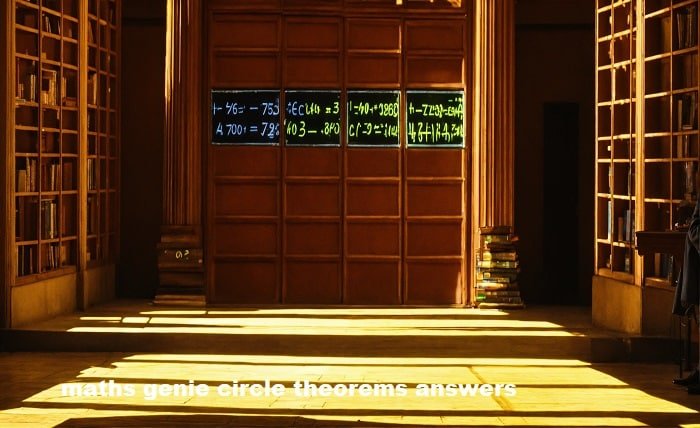Unlocking the Secrets of Circle Theorems: A Comprehensive Guide with Maths Genie Circle Theorems Answers

Circle theorems are a crucial part of geometry that many students encounter during their studies. These theorems help explain the properties of angles, radii, tangents, and chords in a circle. Whether you’re preparing for an exam or simply trying to better understand the topic, Maths Genie Circle Theorems Answers provide clarity, step-by-step solutions, and expert explanations. This guide will walk you through the essential theorems, how to solve problems, and give you the tools you need to master this important aspect of geometry.
The Basics of Circle Theorems
Circle theorems are mathematical principles that govern the relationships between angles and segments within a circle. At the heart of these theorems is the concept of a circle as a set of points that are equidistant from a fixed point called the center. Circle theorems are crucial for solving problems that involve arcs, chords, angles, and tangents. maths genie Circle Theorems Answers break down the solutions for students, making them easier to understand. By learning and applying these theorems, you can confidently tackle geometry problems involving circles.
Key Circle Theorems Every Student Should Know
There are several important circle theorems that students must be familiar with in order to succeed in geometry. Some of the most frequently encountered theorems include:
- The Angle at the Center Theorem: This theorem states that the angle subtended by a chord at the center of the circle is twice the angle subtended at any point on the circumference.
- The Angle in a Semicircle Theorem: According to this theorem, the angle subtended by a diameter at any point on the circle is a right angle.
- The Cyclic Quadrilateral Theorem: This theorem states that the opposite angles of a cyclic quadrilateral (a quadrilateral inscribed in a circle) sum to 180 degrees.
These basic theorems form the foundation for more complex problems. Maths Genie Circle Theorems Answers often give step-by-step instructions on how to apply these concepts in various problems.
How to Apply Circle Theorems in Problem Solving
The most effective way to grasp circle theorems is through practice. Maths Genie Circle Theorems Answers offer plenty of problems to solve, each focusing on a specific theorem or concept. When applying these theorems, students should carefully read the problem and look for known facts, such as the position of angles, the presence of tangents, or the intersection of different lines. Understanding the question is half the battle.
Next, choose the appropriate theorem based on the geometry of the problem. For example, if a question involves an angle subtended by a chord at the center of the circle, the Angle at the Center Theorem is likely the key. Maths Genie Circle Theorems Answers provide solutions by showing how these theorems are applied, step by step, with explanations of the reasoning behind each move.
Common Mistakes and How to Avoid Them
When dealing with circle theorems, it’s easy to make a few common mistakes. One of the most common errors is confusing the angle at the center with the angle on the circumference. Remember that the angle at the center is always twice the size of the angle at the circumference. Another mistake is not recognizing when a quadrilateral is cyclic, which may lead to incorrect use of the Cyclic Quadrilateral Theorem.
maths genie Circle Theorems Answers can help you avoid these mistakes by providing thorough explanations. These answers often highlight specific areas where students may go wrong and offer guidance on how to approach problems methodically. By focusing on these details, you can improve your accuracy and problem-solving skills.
Working with Tangents and Secants in Circle Theorems
Tangents and secants are often involved in problems related to circle theorems. A tangent is a straight line that touches the circle at exactly one point, while a secant is a line that intersects the circle at two points. Many circle theorems deal with the relationships between tangents, secants, and chords.
One common theorem related to tangents is the Tangent-Secant Theorem, which states that if a tangent and a secant intersect at a point outside a circle, the square of the length of the tangent segment is equal to the product of the lengths of the entire secant segment and its external segment.
Maths Genie Circle Theorems Answers will walk you through the application of these theorems, ensuring you understand how to work with tangents and secants in different scenarios.
Advanced Circle Theorems and Their Applications
In addition to the basic circle theorems, there are more advanced theorems that can be helpful in solving complex geometry problems. These include:
- The Alternate Segment Theorem: This states that the angle between a tangent and a chord through the point of contact is equal to the angle subtended by the chord at the opposite side of the circle.
- The Power of a Point Theorem: This theorem deals with the power of a point relative to a circle, where the power of a point is the square of the distance from the point to the center minus the square of the radius of the circle.
These advanced theorems are vital for solving high-level problems in circle geometry. Maths Genie Circle Theorems Answers include solutions to these more advanced questions, helping students build a deeper understanding of how these theorems function in various problem contexts.
Tips for Mastering Circle Theorems
Mastering circle theorems takes practice and a clear understanding of the concepts. Here are a few tips to help you succeed:
- Practice regularly: Solve as many problems as possible to reinforce your understanding of each theorem.
- Visualize the problems: Drawing diagrams can often help clarify complex questions and make it easier to see the relationships between different elements of the circle.
- Use Maths Genie Circle Theorems Answers: These answers offer detailed step-by-step solutions that can help guide you through the problem-solving process.
By following these tips and leveraging the helpful resources provided by Maths Genie Circle Theorems Answers, you’ll be well on your way to mastering circle geometry.
Conclusion
Circle theorems are a fundamental part of geometry, and understanding them is essential for students working in mathematics. The various theorems, such as the Angle at the Center Theorem and the Cyclic Quadrilateral Theorem, offer powerful tools for solving geometry problems. By using Maths Genie Circle Theorems Answers, students can gain access to detailed solutions that provide clear, step-by-step explanations for complex problems. With practice and the right guidance, mastering circle theorems becomes much easier, paving the way for success in exams and mathematics in general.
FAQs
1. What are circle theorems?
Circle theorems are mathematical rules that describe the relationships between angles, lines, and arcs within a circle. They are essential for solving geometry problems.
2. How can I find answers to circle theorem problems?
You can find detailed answers to circle theorem problems through resources like Maths Genie Circle Theorems Answers, which provide step-by-step solutions.
3. What is the Angle at the Center Theorem?
The Angle at the Center Theorem states that the angle subtended by a chord at the center of a circle is twice the angle subtended at any point on the circumference of the circle.
4. How do I apply circle theorems in geometry?
To apply circle theorems, read the problem carefully, identify the relevant theorems, and use them to calculate angles, lengths, and other properties of the circle.
5. Are there advanced circle theorems I should learn?
Yes, there are more advanced circle theorems, such as the Alternate Segment Theorem and the Power of a Point Theorem, which are essential for solving more complex problems.




